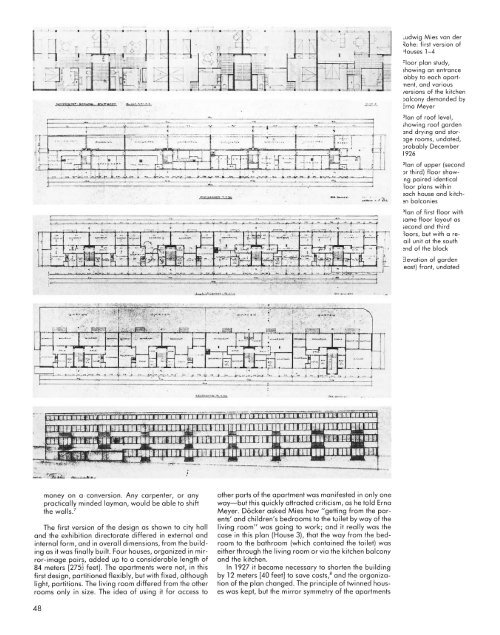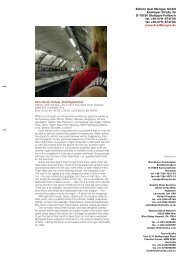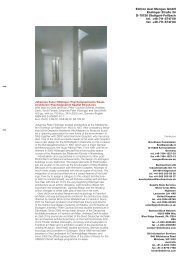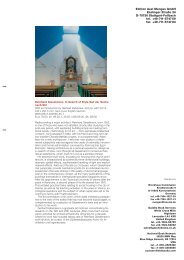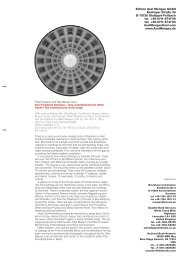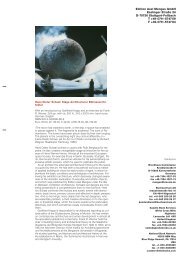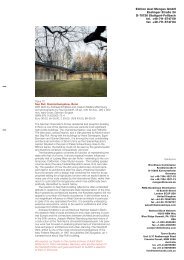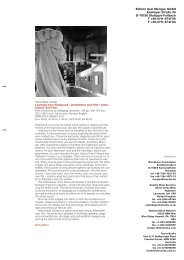Kulka, d - Edition Axel Menges
Kulka, d - Edition Axel Menges
Kulka, d - Edition Axel Menges
You also want an ePaper? Increase the reach of your titles
YUMPU automatically turns print PDFs into web optimized ePapers that Google loves.
Weissenhof, Titelseiten 05.07.2012 15:40 Uhr Seite 7<br />
PREFACE<br />
“The problems of the New Dwelling stem from the altered<br />
material, social and intellectual structure of our time; only<br />
on that basis can these problems be understood.<br />
The degree of structural change determines the character<br />
and extent of the problems. They are in no way arbitrary.<br />
They cannot be solved with catchwords, nor can they<br />
be made to go away by using catchwords.<br />
The problem of rationalization and standardization is<br />
only a subproblem. Rationalization and standardization<br />
are only means, and must never be an end. The problem<br />
of the New Dwelling is basically an intellectual problem<br />
and the struggle for the New Dwelling is only one element<br />
in the great struggle for new lifestyles.”<br />
(Mies van der Rohe, preface to the 1927 exhibition catalogue)<br />
The fundamental significance of the Weissenhofsiedlung<br />
in Stuttgart for the history of early modern architecture<br />
should not be underestimated. Almost all the influential<br />
architects of the 20th century built their proposed solutions<br />
in response to the theme “a home for modern city<br />
dwellers” on the beautifully located slope on the north<br />
side of Stuttgart. The choice of architects and the fact<br />
that a project of this type could be implemented at all so<br />
few years after World War I and the inflation, is one of<br />
the outstanding characteristics of this building exhibition.<br />
“The German Werkbund is aware, and points out<br />
most emphatically that so important a task can only be<br />
successful and have a major impact if it is not only carried<br />
out in a technically flawless manner but also creates<br />
trendsetting architectonic solutions. The Werkbund therefore<br />
recommends to the city of Stuttgart that leading<br />
architects be commissioned with planning the exhibition<br />
and thus assuming a leading role in the construction<br />
of modern housing both in Germany and abroad.” This<br />
memorandum, dated January 1926, concludes with the<br />
following appeal: “It is now up to the municipal council<br />
whether this event, so crucial for the promotion of our<br />
housing, will be able to take place in Stuttgart in 1927.”<br />
An interesting situation thus arose: Members of the<br />
municipal council belonging to all social classes had<br />
to decide on the merits of this pioneering project. The<br />
majority voted for it on 29 July 1926. The result is surprisingly<br />
unambiguous: 25 yes votes, 11 no votes and 6<br />
abstentions.<br />
One might think that after the municipal council<br />
approved the project nothing stood in the way of its<br />
implementation. Far from it. The members of the council’s<br />
construction department interfered even in the selection<br />
of architects. For instance, they rejected Le Corbusier,<br />
who was from western Switzerland, for “national reasons”<br />
and Hans Scharoun because of his “peculiar artistic<br />
attitude”. At the time, so shortly after the end of World<br />
War I, rejection for “national reasons” was understand-<br />
able for everyone: Western Switzerland is French Switzerland,<br />
and France was Germany’s traditional enemy. It<br />
was possible to take care of all these details. As a result<br />
of an argument about the architects’ fees in 1926, Erich<br />
Mendelsohn, Heinrich Tessenow and Hugo Häring, who<br />
had until then been scheduled to be part of the building<br />
team, were replaced by Peter Behrens, Bruno Taut and<br />
Victor Bourgeois. Bourgeois designed a building for a<br />
private client at the site where the Viennese architect<br />
Adolf Loos would have planned to build. (See the chapter<br />
on Victor Bourgeois.)<br />
How did this project ever come to Stuttgart, anyway?<br />
What made it possible was a favorable constellation of<br />
both personnel and chronological circumstances. Gustaf<br />
Stotz must be regarded as the project’s initiator. It was<br />
he who managed to fire up the enthusiasm of the leadership<br />
of the German Werkbund and of the city about the<br />
project. It is also thanks to him that Mies van der Rohe<br />
undertook to be its artistic director. In an interview with<br />
the curator of the Mies van der Rohe Archive at the<br />
Museum of Modern Art in New York, Ludwig Glaeser,<br />
Erna Stotz denied that Stotz had become aware of Mies<br />
through the German Werkbund, saying that it had happened<br />
as a result of the publications of avant-garde<br />
groups. “And then my husband decided it had to be<br />
somebody who was prominent, actually a dark horse” –<br />
a truly unusual selection criterion by today’s standards,<br />
though a shrewd one.<br />
Mies and many of the architects of the Weissenhofsiedlung<br />
were relatively young and not established. They<br />
had a fine reputation in avant-garde circles, but hardly<br />
outside them. This explains why they were rejected by<br />
Paul Bonatz and Paul Schmitthenner, two esteemed academicians<br />
and practicing architects in Stuttgart. Moreover,<br />
in the German Werkbund the entire project was<br />
regarded as not really important – a sort of practice<br />
piece for a “world building exhibition” that would take<br />
place in Berlin in 1930. It is true that there was a building<br />
exhibition there in 1931, but due to the international<br />
economic crisis and unemployment at the end of the<br />
1920s the exhibition proved to be much more modest<br />
than the planners had intended. The building of the<br />
Weissenhofsiedlung took place exactly in the timespan<br />
between the great inflation and great depression. There<br />
would have been no chance of implementing the project<br />
of the German Werkbund and the city of Stuttgart either<br />
prior or subsequent to this period.<br />
The Weissenhofsiedlung was the core of the Werkbund<br />
exhibition titled “the dwelling” (“Die Wohnung”),<br />
which opened on 23 July 1927. It included a total of four<br />
parts and was sited at three different Stuttgart locations.<br />
The Weissenhofsiedlung, with 21 houses comprising 63<br />
dwellings, was built and furnished by 17 architects, i.e.<br />
altogether 55 architects and interior architects. On an<br />
7


